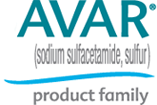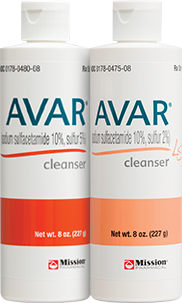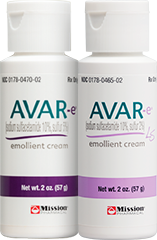Treatments
ACNE VULGARIS TREATMENTS
Over-the-counter (OTC) topical treatments are the first course of therapy for most acne sufferers and can be effective for treating milder cases of acne. The initial side effects (eg, irritation, dryness, and flaking) of these treatments improve after the first month of use.
Some of the common active ingredients found in OTC acne treatments include:
- Benzoyl peroxide, which has an antibacterial and drying effect
- Sulfur, which in a topical form causes drying and peeling of the skin and allows excess dirt and oil to wash away
- Resorcinol, which is a topical agent that breaks down rough or hardened skin
- Salicylic acid, which is a peeling agent that causes the outer layers of the skin to shed
Prescription Topical Treatments. When patients don’t get relief from OTC therapies, they often seek professional help from a dermatologist who can prescribe a stronger treatment. Many of these treatments can cause burning, stinging, redness, or peeling, which can be minimized by gradually increasing the dose, washing off the medication, or switching to another therapy. Some of these topical prescription therapies include topical vitamin A derivatives (eg, tretinoin, adapalene, and tazarotene) which work by promoting cell turnover and preventing hair follicles from getting plugged.
Topical antibiotics are also commonly prescribed and work by killing excessive skin bacteria, another known cause of acne. Often a combination antibiotic and benzoyl peroxide treatment is prescribed to achieve optimal results.
Oral Antibiotics. A short course of oral antibiotics has been effectively used to treat moderate to severe acne by reducing bacteria and fighting inflammation. However, antibiotic resistance is more common these days, which is why physicians tend to reduce their use within 3 to 4 months as symptoms improve or when their continued efficacy comes into question. Studies have shown that pairing oral antibiotics with benzoyl peroxide may reduce the risk of antibiotic resistance. Common side effects of oral antibiotics include upset stomach, dizziness, or skin discoloration. It is also worth noting that antibiotics increase skin’s photosensitivity. Some common antibiotics used to treat acne include tetracycline, doxycycline, minocycline, trimethoprim alone or in combination with sulfamethoxazole, and azithromycin.
Isotretinoin. Sometimes acne is unresponsive to antibiotics. This is typically the case when deep cysts are present. This is when isotretinoin, a powerful medication that is usually reserved for severe acne, is prescribed. The use of isotretinoin-based therapies needs to be carefully monitored by a physician as they are associated with severe birth defects and therefore cannot be safely used by women who may become pregnant even several weeks after treatment has concluded. In fact, women of reproductive age must participate in a specific Food and Drug Administration–approved monitoring program in order to receive these teratogenic medications. Other side effects associated with the use of isotretinoin include dry eyes, mouth, lips, nose, and skin, as well as itching, nosebleeds, muscle aches, sun sensitivity, and impaired night vision. Elevated serum triglycerides and cholesterol, as well as increased liver enzyme levels have also been seen.
Oral Contraceptives. Some oral contraceptives have been shown to improve acne in women, including the combination of norgestimate and ethinyl estradiol. Side effects include nausea, depression, headaches, and breast tenderness. Additionally, use of oral contraceptives comes with an increased risk for high blood pressure, heart disease, and blood clots.
Laser and Light Therapy. Laser treatment is believed to work by damaging the sebaceous glands and causing them to produce less oil, while light therapy targets the bacteria that cause acne inflammation. Both laser and light therapy are able to penetrate the deeper layers of the skin without damaging the skin’s visible surface. As a result, skin texture and the appearance of acne scars can also be improved. These treatments are good options for those patients who cannot tolerate acne medications. Side effects of treatment may mimic severe sunburn and can be uncomfortable.
Cosmetic procedures such as chemical peels and microdermabrasion are commonly used to reduce the appearance of minor facial scars, fine lines, and sun damage. These procedures may also help control acne when used in combination with other acne treatments. Temporary, but severe redness, scaling and blistering, and long-term skin discoloration are among the potential side effects.
ACNE ROSACEA TREATMENTS
While acne rosacea cannot be cured, it can be effectively controlled with treatment. All patients with rosacea are advised to use a broad-spectrum sunscreen on a daily basis. Titanium dioxide and zinc oxide, two physical blockers, are well tolerated.
Some of the medications used to treat acne vulgaris are also used in the treatment of acne rosacea, as there is some overlap between the two conditions. These common treatments include oral and topical antibiotics, sulfa-based face washes, and isotretinoin, to name a few. Patients with rosacea tend to have more sensitive and easily irritated skin than those patients with acne. Therefore, they should be cautious about using OTC acne remedies. They should also be encouraged to avoid astringents, toners, menthols, camphor, waterproof cosmetics that require solvents for removal, or products containing sodium lauryl sulfate. Identifying those factors that trigger a patient’s rosacea should be the first step before commencing therapy. Some common triggers include:
- Hot or cold temperatures
- Hot drinks
- Caffeine
- Exercise
- Spicy food
- Alcohol
- Emotions
- Topical products known for irritating the skin or decreasing the skin’s barrier
- Medications that cause flushing
Topical medications are prescribed first because they present less risk for adverse events, antibiotic resistance, and drug interactions. They reduce redness and inflammation and may be used alone or along with oral medications to control symptoms. Their potential side effects include skin irritation, redness, dry skin, and stinging or burning.
Topical antibiotics, such as metronidazole, help control the redness and bumps associated with rosacea. These drugs are generally well tolerated and considered the recommended topical therapy for rosacea.
Tretinoin, which is a topical derivative of Vitamin A, is also used to treat acne and reduce the appearance of fine lines and wrinkles.
Benzoyl peroxide and azelaic acid are ingredients known for helping to kill the bacteria that cause acne and rosacea.
Topical Corticosteroids are sometimes recommended in a minimal strength to reduce local inflammation. For instance, hydrocortisone 0.5% or 1% cream may be applied sparingly once or twice daily to the affected areas, but steroid use comes with the risk of causing a rosacea flare.
Gentle skin cleansers are recommended to provide symptom relief. Patients should avoid harsh soaps and rubbing or scrubbing their face. Sulfa-based or benzoyl peroxide washes are often recommended, as well as certain OTC brands.
Laser and intense light treatments are often used to treat the continual redness and noticeable blood vessels on the face, neck, and chest that are associated with rosacea. While these treatments may cause discomfort, this can be mitigated with ice packs and topical anesthetic creams.



